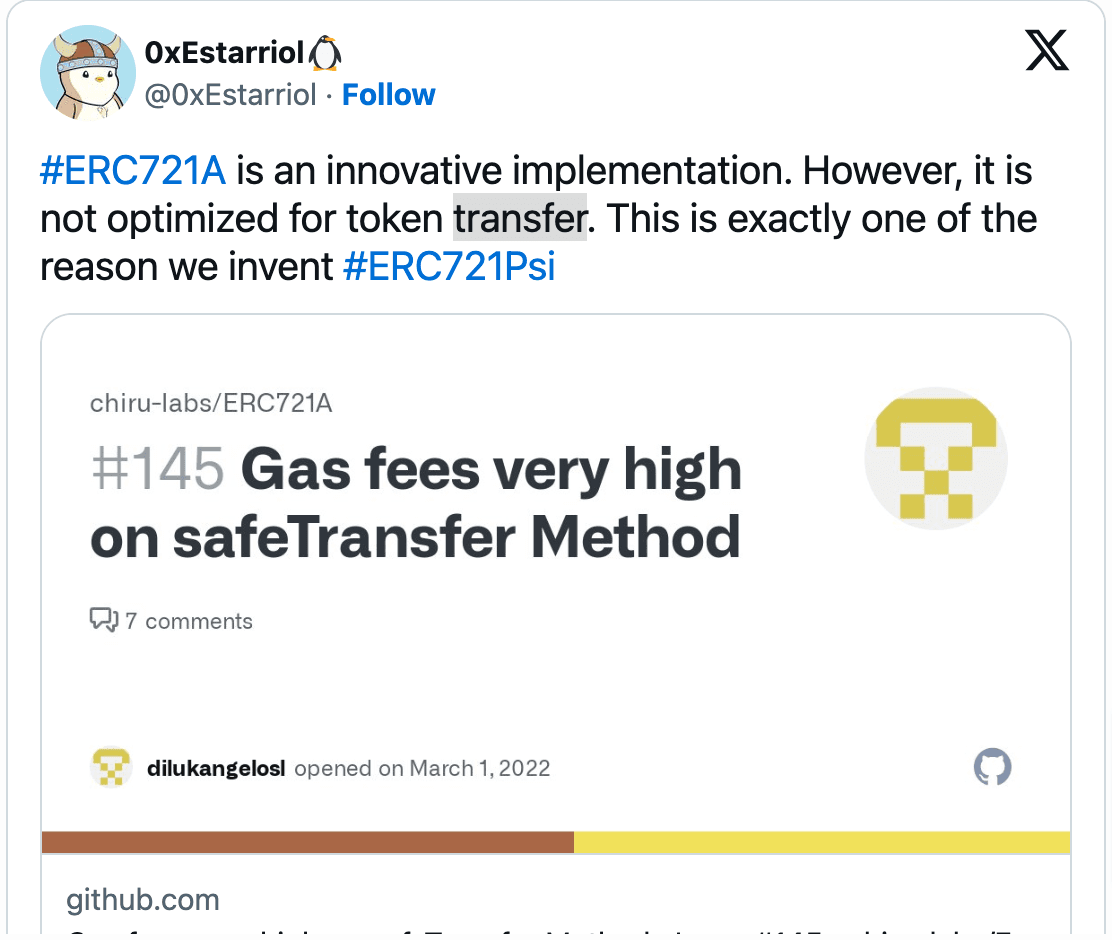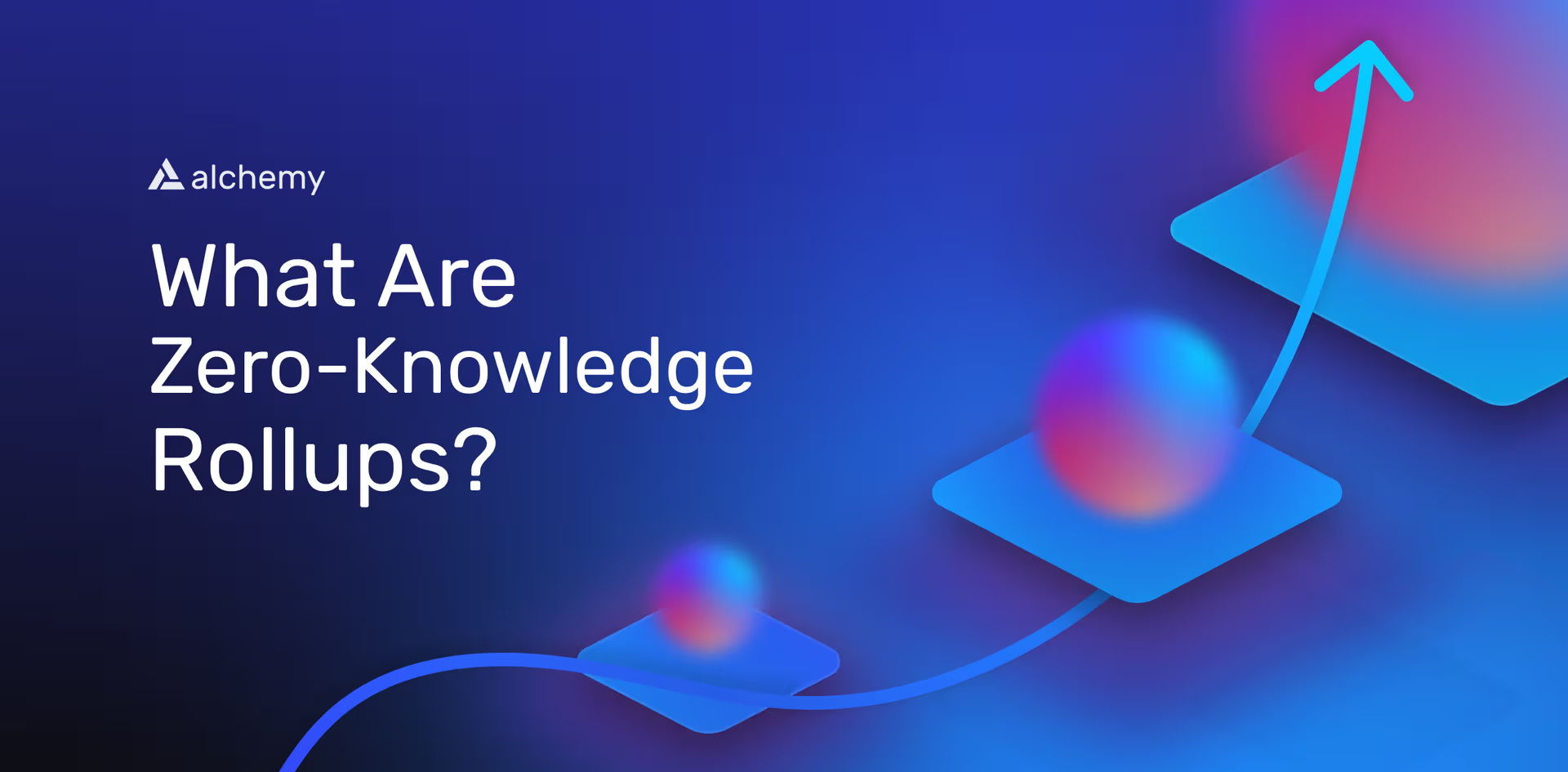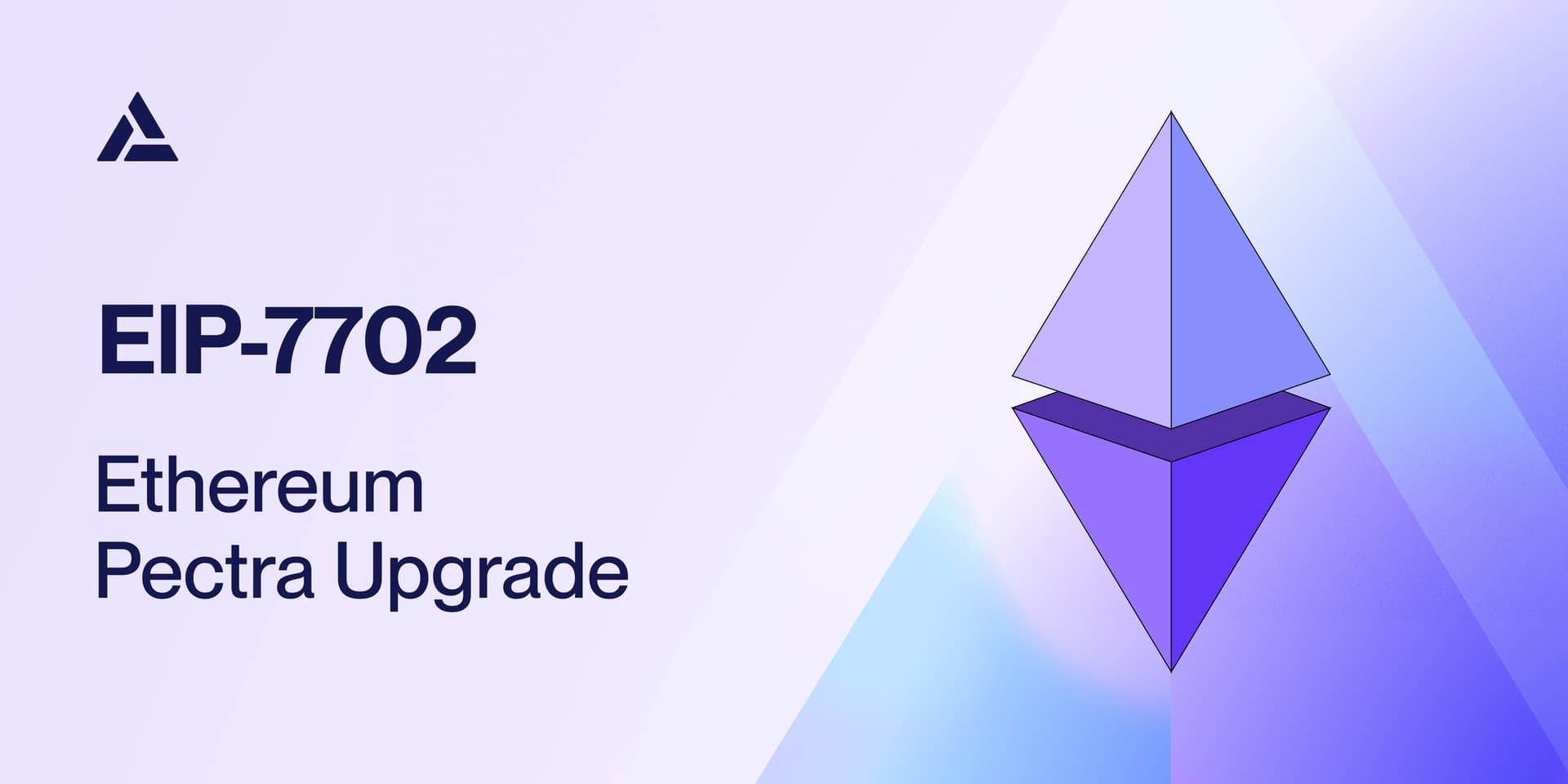ERC721 vs. ERC721A: Batch Minting NFTs
Author: Albert Hu
As many NFT creators know, deploying a smart contract to Ethereum mainnet can be insanely expensive.
However, smart contract deployment costs are not the only cost blockchain engineers and NFT teams need to consider. Creating a successful NFT collection or collectible avatar project includes building a community and making it easy for users to mint, trade, and use their NFTs.
Let’s learn about a powerful NFT smart contract optimization that can help your community save gas fees on NFT minting costs:
Implementing batch minting with the ERC721A contract!
What is ERC721A?
On Jan 6th, the Azuki NFT development team publicly announced ERC721A, a new implementation of the ERC721 NFT standard that explores batch minting:

In their blog post explaining the ERC721A smart contract implementation, @locationtba and @2pmflow show estimates of how much gas can be saved when batch minting via the most commonly used NFT smart contract starter code, OpenZeppelin’s ERC721Enumerable contract, vs. batch minting NFTs using the new Azuki ERC721A contract:

This table shows how the gas used for ERC721A for an increasing number of mints scales at a much smaller constant factor.
The gas cost to mint NFTs increases by:
~2k gas per extra mint using the Azuki ERC721A contract
~115k gas per extra mint using the OpenZeppelin ERC721Enumerable contract
This result is actually AMAZING!
For the price of minting one single token via the ERC721Enumerable contract, a user can instead mint up to 5 tokens (or more, potentially) via the ERC721A contract.
Who wouldn’t want users to save up to 80% on their mints?
Here’s the best part:
Not only do the NFT mint prices become cheaper for individual transactions, but there would also be less network congestion and smaller gas price spikes affecting the Ethereum network during popular collection drops.
Pretty cool stuff.
Verifying the gas savings for minting multiple NFTs
I wanted to check the work myself, so I implemented two basic NFT contracts that create NFTs:
Next, I called the mint function on each one and logged the gas costs for each transaction.
Here are my results:
thatguyintech@albert demo-erc721a % npx hardhat test
OpenZeppelin ERC721Enumerable
gas to mint 1: 104138
gas to mint 2: 219626
gas to mint 3: 335114
gas to mint 4: 450602
gas to mint 5: 566090
Azuki ERC721A
gas to mint 1: 93704
gas to mint 2: 96212
gas to mint 3: 98720
gas to mint 4: 101228
gas to mint 5: 103736
You can find the code for these tests in this GitHub repo: demo-erc721a
The gas costs to make multiple NFTS here are slightly different than the ones shown in the Azuki blog post, but they are close, and the increase in gas fees from one mint, two mints, and multiple mints checks out.
We’ve validated the gas savings for batch minting NFTs! ✅
How does the ERC721A smart contract save gas fees with batch minting?
ERC721A makes some assumptions that influence its smart contract design:
Token IDs should always increment consecutively starting from 0. Most NFT projects already do this, and Azuki is explicit about it in their assumptions.
Reducing the gas costs of minting NFTs is more important than optimizing any other ERC721 call. Mints are when Ethereum network congestion happens, and they’re also users’ first impressions of an NFT collection. The easier the mint, the better the reputation.
With these assumptions in place, ERC721A makes the following contract optimizations:
Reduce wasted storage of token metadata.
Limit ownership state updates to only once per batch mint, instead of once per minted NFT.
We’ll take a look at how these optimizations are done, but before that we should understand what kinds of transactions cost the most gas fees.
Reducing the work required to send write transactions saves users gas
There are generally two kinds of transactions on the blockchain: writes and reads.
Writes happen when we modify or update blockchain state (e.g. sending money, writing a message, trading an NFT).
Reads happen when we request existing data to look at it.
Users always pay more gas fees for write functions than they pay for read functions.
Therefore, by reducing the number of write transactions, OR by reducing the work required to send write transactions, even if it takes more work to send read transactions later, this will reduce the NFT minting costs that users pay!
And that’s exactly what ERC721A accomplishes.
When it comes to NFT mints: mo’ storage, mo’ problems. Less storage, less problems.
Brilliant, right?
So how do ERC721A smart contract optimizations work?
Let’s take a quick tour of the code to really understand how the optimizations work.
The base ERC721 contract tracks Owners,Balances, Token Approvals and Operator Approvals :
//////////////////
///// ERC721 /////
//////////////////
// Mapping from token ID to owner address
mapping(uint256 => address) private _owners;
// Mapping owner address to token count
mapping(address => uint256) private _balances;
// Mapping from token ID to approved address
mapping(uint256 => address) private _tokenApprovals;
// Mapping from owner to operator approvals
mapping(address => mapping(address => bool)) private _operatorApprovals;
Now, in the ERC721Enumerable extension contract, OpenZeppelin adds additional state to track tokenIds and owned tokens:
////////////////////////
/// ERC721Enumerable ///
////////////////////////
// Mapping from owner to list of owned token IDs
mapping(address => mapping(uint256 => uint256)) private _ownedTokens;
// Mapping from token ID to index of the owner tokens list
mapping(uint256 => uint256) private _ownedTokensIndex;
// Array with all token ids, used for enumeration
uint256[] private _allTokens;
// Mapping from token id to position in the allTokens array
mapping(uint256 => uint256) private _allTokensIndex;
Without this extra storage, the base ERC721 contract cannot implement important NFT collection functions such as totalSupply(), tokenOfOwnerByIndex, and tokenByIndex.
These functions are necessary for keeping tokenIds organized and for handling other NFT logistics. That’s why so many NFT projects use ERC721Enumerable.
However, maintaining these three additional mappings and one extra array means that for every call to mint a new NFT, all of this state has to be updated.
For example _ownedTokens, _ownedTokensIndex, _allTokens, and _allTokensIndex will each have new data added into their storage.
By studying existing NFT projects, the Azuki team noticed that most NFT projects do not need the excessive set of storage variables, so they re-architected and simplified their design.
The ERC721A contract leverages some new structs to re-implement the base ERC721 state variables for ownership and tracking balances:
///////////////////
///// ERC721A /////
///////////////////
// Mapping from token ID to ownership details
// An empty struct value does not necessarily mean the token is unowned. See ownershipOf implementation for details.
mapping(uint256 => TokenOwnership) private _ownerships;
// Mapping owner address to address data
mapping(address => AddressData) private _addressData;
// Mapping from token ID to approved address
mapping(uint256 => address) private _tokenApprovals;
// Mapping from owner to operator approvals
mapping(address => mapping(address => bool)) private _operatorApprovals;
struct TokenOwnership {
address addr;
uint64 startTimestamp;
}
struct AddressData {
uint128 balance;
uint128 numberMinted;
}
The magic lies in how these new structs are used.
In the ERC721A _safeMint implementation, owner balances are updated only once, no matter how many NFTs are minted in the batch call.
In the code below, you can see that there is a single assignment to the _addressData mapping via _addressData[to] = AddressData(...);.
// Update the owner balance data only once.
AddressData memory addressData = _addressData[to];
_addressData[to] = AddressData(
addressData.balance + uint128(quantity),
addressData.numberMinted + uint128(quantity)
);
_ownerships[startTokenId] = TokenOwnership(to, uint64(block.timestamp));
uint256 updatedIndex = startTokenId;
// Emitting
for (uint256 i = 0; i < quantity; i++) {
emit Transfer(address(0), to, updatedIndex);
require(
_checkOnERC721Received(address(0), to, updatedIndex, _data),
"ERC721A: transfer to non ERC721Receiver implementer"
);
updatedIndex++;
}
currentIndex = updatedIndex;
In the base ERC721 contract before, this assignment would have had to be done in a loop, one time for each NFT being minted in the batch group. Now it’s done in a single update.
With fewer maps to update, and fewer instances of updates to begin with, each mint transaction costs a lot less, especially as the batch size gets larger and larger!
What are the risks of using ERC721A contracts to generate multiple NFTs?
Cheaper mints sound awesome! Are there any downsides? (Yes)
The tradeoff of the ERC721A contract design is that transferFrom and safeTransferFrom transactions cost more gas, which means it may cost more to gift or sell an ERC721A NFT after minting.
The ERC721A _safeMint logic makes efficiency gains by not setting explicit owners of specific tokenIDs when they are consecutive IDs minted by the same owner.
For example, in the photo below, there are two batch mint calls, one by Alice to mint tokens #100, #101, and #102 all in one call, and another call by Bob to mint tokens #103 and #104.

The ERC721A contract only has to set the ownership metadata twice: once for the Alice’s batch and once for Bob’s batch.
However, this means that transferring a tokenID that does not have an explicit owner address set, the contract has to run a loop across all of the tokenIDs until it reaches the first NFT with an explicit owner address to find the owner that has the right to transfer it, and then set a new owner, thus modifying ownership state more than once to maintain correct groupings.
Here’s a test to simulate transfer scenarios and log gas costs:

They way to read this chart is to go x-axis first, and then y-axis, like:
“Mint a batch of 1 NFT, then transfer tokenID 0”, or
“Mint a batch of 3 NFTs, then transfer tokenID 1”, or
“Mint a batch of 5 NFTs, then transfer tokenID 4”
From these results, we can see that transferring tokenIDs in the middle of a larger mint batch (i.e. t1, t2) costs more than transferring tokenIDs on the ends of the batch (i.e. t0, t4).
Note that this quick experiment only tracks the cost of a single transfer after mint.
A workaround to decrease transfer costs after batch minting NFTs
Here’s an interesting solution to minimize the total cost of transferring your entire batch of NFTs (original source from William Entriken @fulldecent):
Always mint the maximum allowed number of NFTs during the batch mint.
When transferring, start with the ODD numbered tokens first in ASCENDING order.
After that, transfer EVEN numbered tokens.

This strategy works because it forces population of the _addressData mapping, making subsequent transfers cheaper to execute.
Examples of NFT projects using ERC721A contracts
Here is a set of projects that are currently using the ERC721A contract:
@AzukiZen
@cerealclubnft
@TheLostGlitches
@standardweb3
@KittyCryptoGang
@XRabbitsClub
@WhaleTogether
@pixelpiracynft
@dastardlyducks
@MissMetaNFT
@StarcatchersNFT
@LivesOfAsuna
@richsadcatnft
@themonkeypoly
@womenofcrypto_
@TravelToucans
@HuhuNFT
ERC721A Alternatives for batch minting NFTs
And for those who are more adventurous, take some time to check out an even newer optimization of the ERC721 standard called ERC721Psi:

We won’t get into ERC721Psi in this article, but if you’re curious and want to learn more about how that one works, let me know by shooting me a tweet @thatguyintech, and I’ll be sure to do another deep dive on it!
We can even explore deploying some sample projects using Alchemy.
Are ERC721A contracts still considered NFTs?
The short answer is yes, ERC721A contracts are definitely NFTs.
Any contract that implements the ERC721 token standard or ERC1155 interfaces are considered non-fungible tokens or semi-fungible tokens.
ERC721A is an extension and optimization of the ERC721 standard.
The same is true for ERC721Enumerable and ERC721Psi.
They’re all part of the ERC721 family!
How to burn ERC721A tokens
When you want to get rid of an NFT or a token that you have in your wallet, but you don’t want to give it to another person, and you don’t want to sell it, you can burn it by sending it to a specific wallet address that no one uses.
A lot of people like to use the same burn addresses because they are easy to remember.
For example, the 0 address:
0x0000000000000000000000000000000000000000
However, when it comes to ERC721A NFTs, you cannot transfer tokens to the 0 address to burn NFTs because most tokens minted in a batch are mapped to the 0 address by default.
Pick another address with which to burn your ERC721A NFTs and you’ll be fine!
For example, another common burn address is the "0xdead" address: 0x000000000000000000000000000000000000dEaD
Will you use the ERC721A contract to batch mint your NFTs?
The ERC721A contract is a powerful way to save your community gas costs and save the Ethereum network from unnecessary congestion by batch minting NFTs.
Let us know what kind of an NFT project you’re building and how we can help! We have tools to help you deploy, monitor, notify, and market your next NFT collection.
Don’t wait, shoot us a tweet @AlchemyPlatform or send a DM and let’s chat!
Alchemy Newsletter
Be the first to know about releases
Sign up for our newsletter
Get the latest product updates and resources from Alchemy
By entering your email address, you agree to receive our marketing communications and product updates. You acknowledge that Alchemy processes the information we receive in accordance with our Privacy Notice. You can unsubscribe anytime.
Related articles

What are Zero-Knowledge Rollups (ZK-rollups)?
Explore ZK-rollups, a fast-growing L2 design. Learn how they cut costs, enable instant finality, and boost security.

Deploying Scalable Custom Rollups with a RaaS in 2025
Ambitious teams are increasingly deploying a rollup with RaaS in 2025. Here's why.

EIP-7702: Quick Integration Guide for Ethereum Developers Post-Pectra
Ethereum is on the brink of an important upgrade with EIP-7702. Here's a quick guide on integration considerations for all developers.